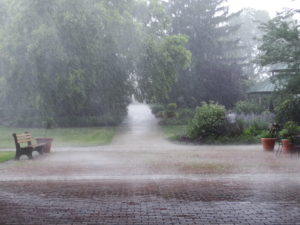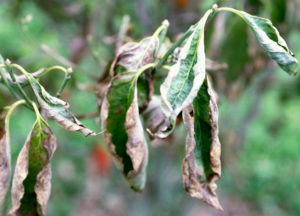The Summer Storm Fakeout
July 26th, 2016
Don’t be lulled into hoselessness by those quick-hit summer storms.

Those summer downpours might look like they’re helping plants, but a lot of the water may be running off.
Credit: Sonny Bender
Also don’t assume that just because the grass isn’t brown and crunchy that there’s no need to worry about watering the plants.
It’s been very hot and very dry lately, and the soil down in the root zone may not be as damp as you think – especially if you’re in those unfortunate pockets that keep missing the storms.
Summer storms can be major fakeouts on three fronts:
1.) They’re spotty. It’s entirely possible for one area to get a 2-inch dumping but then nothing falls a half-mile away.
2.) Summer storms often look like they’re delivering more rain than they really do. I can’t tell you how many times I’ve seen heavy winds and heavy rains roll through, only to find a quarter-inch of water in my rain gauge.
3.) The rain can come down so fast that more of it ends up in the sewer system than around your hydrangea roots.
What really counts is how much moisture is in the soil where the roots are.
Those 10-minute downpours often deposit only enough water to wet the mulch or to penetrate the lawn surface – just enough to keep the grass green. That’s why it’s not a good idea to let the color of the grass act as your “rain gauge.”
Get a real rain gauge to see exactly how much rain fell in your yard. It doesn’t matter if the official measurement from Harrisburg International Airport says a storm dropped an inch if all you got was a misting.
Even better, stick your finger in the ground in different beds to see just how damp the soil is at what depth. You could also buy a moisture meter, but I’ve found that a good, old, low-tech index finger works just as well.
If you were lucky enough to get the decent dumping from Monday evening’s storms, your soil might be much improved from the dust-building conditions over the weekend.
Day after day of 90-degree heat combined with dry air has been literally sucking the moisture out of plant leaves and the ground.
The forecast is more of the same, so it might not take long for the soil to dry again even if you got a half-inch or so from Monday’s rain.
Plants usually let you know they need water by first losing their lustrous leaf and flower color, then by wilting and/or browning around the leaf edges.

If leaves are browning around the edges, they need water ASAP (and better yet, yesterday).
It’s best, though, if they don’t get to that point. Those are stress signs that growth already has been affected and that the plant is in danger of croaking altogether if it doesn’t get some moisture soon.
Pay particular attention to things you’ve planted in the last year since the roots won’t be fully established. With trees and larger shrubs, it can take 4 to 5 years before plants can weather dry heat waves on their own.
Give those bigger-rooted plants a deep soaking, too. I’ve seen young trees die from lack of water even when people swear they’ve watered every day. That’s because the amount applied is only enough to wet the mulch or soil surface – the same non-root-help as a quick-hit summer storm.
So how do you know enough is enough?
That’s where your finger or your soil-moisture meter comes in. Some techies are even investing in digital probes that send moisture readings wirelessly to a smart phone (when they actually work).
For veggies and flowers, check the soil 3 or 4 inches deep. Next to trees and shrubs where you need to monitor deeper, use a stick or stake (unless your fingers are 8 inches long).
Really, your watering goal is pretty simple – keep the soil consistently damp all around and to just below the plant’s roots.
Rules like, “1 inch of water per week” or “Water a tree for 15 minutes” help, but they’re not as useful as finger feedback.
One reason why one-size-fits-all advice doesn’t always work is that different plants have different needs.
A shallow annual petunia or a pepper plant, for example, benefits more from regular and shallow waterings, say, every other day in hot, dry weather. A big-rooted tree or shrub, on the other hand, fares better with a deeper soaking once or twice a week.
Weather is another variable. Plants burn through way more soil moisture when it’s hot, windy and not so humid as when it’s cool and cloudy or even warm and humid.
Your soil and your water pressure make a difference, too. Sandy soils drain faster than clay soils. Or my hose might put out a lot more water in 15 minutes than yours.
Mulch is another huge variable. Mulched soil dries out less quickly than bare soil. One to 2 inches of mulch is good around flowers; 3 to 4 inches is ideal around trees and shrubs.
Whenever you water, make sure it’s going on slow enough that it’s not running off. Your sidewalk is drought-tolerant and needs no water.
Be patient. It’s probably going to take more time and more water than you think to do the deed adequately.
If you’re not patient, get a sprinkler or rig up a drip-irrigation system.
After you think you’ve applied enough, give the water 15 to 30 minutes to soak in. Then do the finger check. That’ll tell you if estimated well.
Remember, if your plants are wilting, the best time to water was yesterday.







